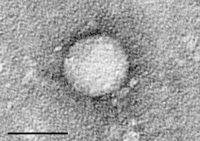
Photo from wikipedia
PURPOSE OF REVIEW With the advent of direct acting antiviral (DAA) therapy, the use of organs from hepatitis C virus infected (HCV+) donors is gaining more traction. In this review,… Click to show full abstract
PURPOSE OF REVIEW With the advent of direct acting antiviral (DAA) therapy, the use of organs from hepatitis C virus infected (HCV+) donors is gaining more traction. In this review, we aim to: provide an overview of recent literature that supports the use of HCV+ organs, outline ongoing challenges to the use of these organs, and highlight the areas within this field where active investigation is ongoing. RECENT FINDINGS The present review describes clinical outcomes related to the transplantation of both HCV+ nonviremic and viremic organs and the distinction between hepatic and nonhepatic transplants. It also discusses the current debate pertaining to the ideal treatment strategy for donor-derived HCV infection, that is pre-emptive therapy versus prophylaxis therapy. SUMMARY Data suggest that the use of HCV+ organs is an effective and relatively well tolerated strategy to combat the organ scarcity. However, clinicians must be vigilant to a signal of increased inflammation as HCV+ organ transplantation becomes more universal. Recent studies suggest that shorter courses of DAA may sufficiently treat donor-derived HCV infection, however the best treatment approach to minimize risk, cost, and toxicity is still under investigation.
Journal Title: Current Opinion in Organ Transplantation
Year Published: 2020
Link to full text (if available)
Share on Social Media: Sign Up to like & get
recommendations!